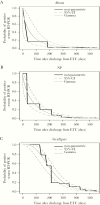A 40-Month Follow-Up of Ebola Virus Disease Survivors in Guinea (PostEbogui) Reveals Long-Term Detection of Ebola Viral Ribonucleic Acid in Semen and Breast Milk
- PMID: 32128327
- PMCID: PMC7047953
- DOI: 10.1093/ofid/ofz482
A 40-Month Follow-Up of Ebola Virus Disease Survivors in Guinea (PostEbogui) Reveals Long-Term Detection of Ebola Viral Ribonucleic Acid in Semen and Breast Milk
Abstract
Background: With the increasing frequency and impact of Ebola virus disease (EVD) outbreaks illustrated by recent epidemics, a good understanding of the extent of viral persistance or ribonucleic acid (RNA) detection in body fluids from survivors is urgently needed.
Methods: Ebola viral RNA shedding was studied with molecular assays in semen (n = 1368), urine (n = 1875), cervicovaginal fluid (n = 549), saliva (n = 900), breast milk (n = 168), and feces (n = 558) from EVD survivors in Guinea (PostEbogui cohort, n = 802) at a regular base period until 40 months after inclusion.
Results: Twenty-seven of 277 (9.8%) male survivors tested positive for Ebola RNA in at least 1 semen sample. The probability of remaining positive for Ebola RNA in semen was estimated at 93.02% and 60.12% after 3 and 6 months. Viral RNA in semen was more frequent in patients with eye pain (P = .036), joint pain (P = .047), and higher antibody levels to Ebola virus antigens (nucleoprotein [P = .001], glycoprotein [P = .05], and viral protein-40 [P = .05]). Ebola RNA was only rarely detected in the following body fluids from EVD survivors: saliva (1 of 454), urine (2 of 593), breast milk (2 of 168), cervicovaginal secretions (0 of 273), and feces (0 of 330). Ribonucleic acid was detected in breast milk 1 month after delivery but 500 days after discharge of Ebola treatment unit (ETU) in 1 woman who became pregnant 7 months after discharge from the ETU.
Conclusions: The frequency and potential long-term presence of viral RNA in semen confirmed that systematic prevention measures in male survivors are required. Our observation in breast milk suggests that our knowledge on viral reservoir in immune-privileged sites and its impact are still incomplete.
Keywords: Ebola; Guinea; body fluids; breast milk; semen.
© The Author(s) 2019. Published by Oxford University Press on behalf of Infectious Diseases Society of America.
Figures

Similar articles
-
Temporal evolution of the humoral antibody response after Ebola virus disease in Guinea: a 60-month observational prospective cohort study.Lancet Microbe. 2021 Dec;2(12):e676-e684. doi: 10.1016/S2666-5247(21)00170-1. Epub 2021 Sep 3. Lancet Microbe. 2021. PMID: 35544108
-
Multidisciplinary assessment of post-Ebola sequelae in Guinea (Postebogui): an observational cohort study.Lancet Infect Dis. 2017 May;17(5):545-552. doi: 10.1016/S1473-3099(16)30516-3. Epub 2017 Jan 14. Lancet Infect Dis. 2017. PMID: 28094208
-
Ebola RNA Persistence in Semen of Ebola Virus Disease Survivors - Final Report.N Engl J Med. 2017 Oct 12;377(15):1428-1437. doi: 10.1056/NEJMoa1511410. Epub 2015 Oct 14. N Engl J Med. 2017. PMID: 26465681 Free PMC article.
-
Review of Ebola virus disease in children - how far have we come?Paediatr Int Child Health. 2021 Feb;41(1):12-27. doi: 10.1080/20469047.2020.1805260. Epub 2020 Sep 7. Paediatr Int Child Health. 2021. PMID: 32894024 Review.
-
Pathogenesis of Uveitis in Ebola Virus Disease Survivors: Evolving Understanding from Outbreaks to Animal Models.Microorganisms. 2020 Apr 20;8(4):594. doi: 10.3390/microorganisms8040594. Microorganisms. 2020. PMID: 32325950 Free PMC article. Review.
Cited by
-
Long-term cellular immunity of vaccines for Zaire Ebola Virus Diseases.Nat Commun. 2024 Sep 3;15(1):7666. doi: 10.1038/s41467-024-51453-z. Nat Commun. 2024. PMID: 39227399 Free PMC article. Clinical Trial.
-
YF17D-vectored Ebola vaccine candidate protects mice against lethal surrogate Ebola and yellow fever virus challenge.NPJ Vaccines. 2023 Jul 11;8(1):99. doi: 10.1038/s41541-023-00699-7. NPJ Vaccines. 2023. PMID: 37433816 Free PMC article.
-
Viral persistence, reactivation, and mechanisms of long COVID.Elife. 2023 May 4;12:e86015. doi: 10.7554/eLife.86015. Elife. 2023. PMID: 37140960 Free PMC article. Review.
-
The role of immune activation and antigen persistence in acute and long COVID.J Investig Med. 2023 Jun;71(5):545-562. doi: 10.1177/10815589231158041. Epub 2023 Mar 6. J Investig Med. 2023. PMID: 36879504 Free PMC article. Review.
-
Viral Infections and Male Infertility: A Comprehensive Review of the Role of Oxidative Stress.Front Reprod Health. 2022 Feb 3;4:782915. doi: 10.3389/frph.2022.782915. eCollection 2022. Front Reprod Health. 2022. PMID: 36303638 Free PMC article. Review.
References
-
- Malvy D, McElroy AK, de Clerck H, et al. . Ebola virus disease. Lancet 2019; 393:936–48. - PubMed
-
- World Health Organization. 2016 Situation Report: Ebola Virus Disease. Geneva: World Health Organization; 2016.
-
- Mbala-Kingebeni P, Pratt CB, Wiley MR, et al. . 2018 Ebola virus disease outbreak in Équateur Province, Democratic Republic of the Congo: a retrospective genomic characterisation. Lancet Infect Dis 2019; 19: 641–7. - PubMed
-
- Mbala-Kingebeni P, Aziza A, Di Paola N, et al. . Medical countermeasures during the 2018 Ebola virus disease outbreak in the North Kivu and Ituri Provinces of the Democratic Republic of the Congo: a rapid genomic assessment. Lancet Infect Dis 2019; 19: 648–57 - PubMed
-
- World Health Organization. Ebola situation reports: Democratic Republic of the Congo. Available at: https://www.who.int/ebola/situation-reports/drc-2018/en/. Accessed 15 October 2019.

